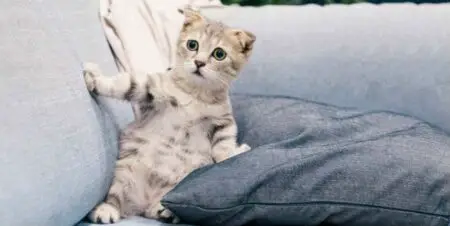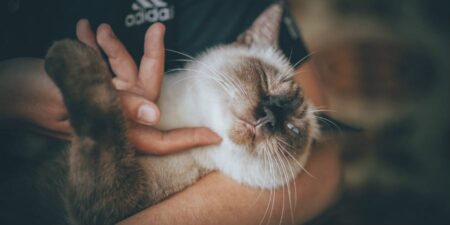Cats are popular and beloved members of society, but they are also mysterious creatures. Anyone that shares their life with a feline will eventually have a list of questions about why their cat makes certain sounds and performs specific movements. Animal behaviorists study cats to help everyone better understand what the habits of these creatures really mean.
The discoveries of experts regarding animal body language enable pet owners to appreciate their pets more, as well as to make it easier provide them with a happier and healthier life. One of the most common questions from people that share their home with a cat is why these animals arch their backs so often.
Luckily, there have been a number of studies on this type of cat behavior that help to explain the pose. Let’s review them.
[amazon bestseller=”cat grooming glove”]
1. Designed for Movement
Many animals arch their backs, but part of the attention to back arching with cats is due to how dramatically they perform the movement. The shoulder blades of felines (and many other four-legged creatures) are attached with muscle rather than bone, so they have a lot of freedom of movement in the shoulders that humans lack. However, the main reason for their ability to complete the exaggerated stance is the flexibility of their spine.
The spine of the cat is different because it rotates more than the spines of other animals. The rotation of the spine allows cats to twist themselves in a variety of ways without injury. Flexible cushioning on the discs of the vertebrae also contribute to how easily cats can contort their bodies.
The flexibility of the spine of the cat enables them to perform a very tight back arch. The freedom in the shoulders allows the animal to also extend their body dramatically at the same time. The combination of these two abilities is why cats can flex and stretch their bodies in such noticeable positions.
2. Prepared for Action

As a cat awakens, one of the first movements it will make is to stand up and arch its back. The movement is a common stretch performed after napping that is meant to limber the animal and make their body supple and ready for action. The stretch increase blood flow that helps to make the cat more alert.
These types of stretches are common natural behavior for any predator. Even housecats that only have a canine roommate to prey on is still a wild predator at heart. The nature of the cat is to be ready for anything, so the stretch ensures their body can take on any challenge.
It may seem hard to believe the stretch is to prepare the cat for a hunt or battle. Many cats will sit and look around immediately after their stretching session ends. This is also a natural reaction as the cat will survey its surroundings before it decides on a safe route to where it wants to go next.
It is also not unusual for a cat to stand up mid-nap and arch their back only to lay back down and continue to sleep. Like humans, cats stretch their bodies because it makes them feel good. The increase in blood flow helps to release lactic acid built up in the body and soothes the muscles and joints, so the cat is more comfortable for their nap.
3. Displays of Enjoyment
The behavior of cats as they are scratched or petted can bewilder people that only share their homes with dogs. A canine will usually hold a position while they receive affection from their owner or another human. Cats rarely stay still and will instead wiggle and twist around when they are being stroked or scratched.
Cats do not move around when being petted because the affection the human gives is unsatisfactory. In fact, felines use this movement to show their pleasure and happiness with the activity. The arch of their back as a hand glides across it is a way for them to communicate their appreciation of the touch.
A cat that arches their back and makes aggressive or pained sounds when their backs are stroked could be signaling something other than appreciation. The combination of movement and sound could mean the cat has some type of discomfort, and the pressure from being touched makes them uncomfortable. Check for signs of skin problems or injury if the back arch seems to be caused by tension and contact a veterinarian if the vocal response continues.
A cat that walks around the house with their back arched for no apparent reasons may be doing so because of a medical problem. An arched back and a hunched position are often the signs of stomach pain. The cat may seem to be curling in towards the painful area to create a shield to protect the tender area.
[amazon bestseller=”Cat Pain Relief”]
4. Ready for Play
Predators of all types often use play fighting to train themselves for a hunt or an attack or to stay skilled at their movements. The arched back of a cat involved in this type of play is a part of their training. Arched backs have a key role in the aggressive behaviors of cats, whether it is for play or done for fear or anger.
Cats taking part in a game with their owners or with other friendly animals will have a much different appearance than when they are showing aggression. Playful cats do arch their backs, turn sideways and hop around like a cat ready for battle. Rarely will a cat in play mode raise all its fur, bare its teeth or produce aggressive growls or hissing sounds.
Cats, particularly kittens, will often approach other cats with their backs noticeably arched and may even bump into them to draw their attention. The movement is an invitation to play and may be followed by the initiator pouncing on the other animal or pawing at them. Again, the animal in these circumstances will look and sound playful rather than angry.
5. Show of Aggression
The arch of a back that takes place when a cat feels threatened is a show of aggression or fear. Cats will arch their backs and turn sideways to make themselves seem larger to their enemies. The desire to seem bigger and more fearsome is the same reason why they puff out the fur on their bodies and their tails at the same time they arch their back.

The arched stance is meant as a warning of an impending attack towards whatever is causing the animal to feel stressed. Any attempt to approach a feline at this point, even if the intent is to calm them, could result in a bite or scratches, or both. Cats do not necessarily want to fight, but in the haze of fear or anger, they may feel they have no choice.
Aggressive stances include many other types of body language that make it easy to determine that this is not a cat that is looking for playtime. A cat that is angry or stressed may also tuck back their ears, bare their teeth and hiss or growl. The position of the ears can make it possible to tell if a cat is an aggressor or defender in the incident.
All cats lower their ears in any type of stressful situation, but the position of the lowered ears reveals how the cat feels at that moment. Ears that are lying flat against the head or pointing back are a sign of a cat that is scared and defending themselves. An aggressor or angry cat will lower their ears and point them to the side.
6. Waiting for Affection
An arched back on a cat that is happily twisting around the legs of a human or rubbing against their owner or an animal friend is showing their excitement at the possibility of affection. The body position and behavior are how the cat lets others know they are happy to see them. The movement and posture say they are ready to be petted or loved in some way.
The amount of body language expressed by cats through a simple back arch shows the complexity of the creatures and how important the subtle details are to fully understand its message. Pet owners that want to communicate more easily with their cats need to become fluent in the body language of their pet. An appreciation of their emotions and an adequate response to their requests will help to build a lifelong bond.
[amazon bestseller=”cat toys”]
"In ancient times cats were worshipped as gods; they have not forgotten this."
-- Terry Pratchett





